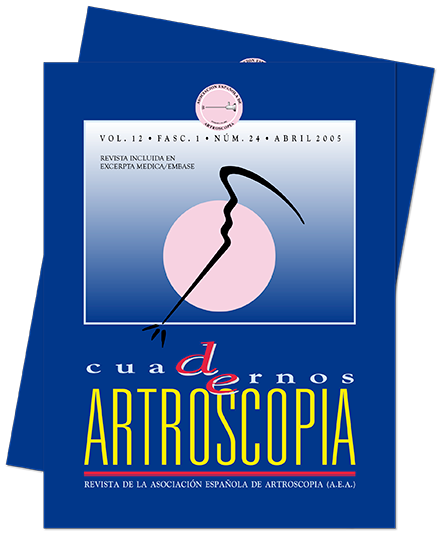Resumen:
Este estudio pretende conocer si la edad de los pacientes es un factor diferenciador en cuanto a la activación de Puntos Gatillo Miofascia!es (PGM) tras la cirugía artroscópica de rodilla, y en cuanto a las posibles causas de activación.
El estudio ha sido realizado con una muestra de 46 pacientes divididos en dos grupos, A y
B (24 y 22 pacientes, respectivamente), con edades medias de 25,08 y 55,41 años, respectivamente.
Se les sometió a una exploración general periódica de la rodilla y en particular de la musculatura relacionada con el dolor miofascial en la zona buscando PGM. Sólo se tuvieron en cuenta los PGM activos con posterioridad a la intervención. Se procedió al análisis estadístico de los datos mediante el programa SPSS versión 11.5 para Windows mediante las pruebas de la t de Student, Chi cuadrado y exacta de Fisher.
Los datos muestran unos porcentajes de activación de PGM del 50% en el grupo A, y del 68,2% en el grupo B.
Destaca la cantidad de activaciones causadas por la isquemia quirúrgica, aunque la posibilidad de compartir causas en las activaciones no es despreciable. El flexo de rodilla y el dolor y/o adherencias en los portales de entrada tienen importancia cuando se combinan, sobre todo, con la isquemia.
La ausencia de diferencias significativas entre ambos grupos hace pensar que la edad no es un factor diferenciador en cuanto a las activaciones de Puntos Gatillo Miofasciales ni en cuanto a las causas de activación.
Abstract:
This study intends to find whether the patients age could be a significant factor in the Myofascial Trigger Point activation after surgical arthroscopy of knee, and its relation to possible causes of activation.
The study has been carried out with a sample of 46 patients distributed in two groups, A and B. (24 and 22 patients respectively) with average ages of 25.08 and 55.41 years old respectively.
A general periodic exploration of the knee and an exploration of the musculature related to the myofascial pain were performed in each indiv’idually periodically by looking for PGM. Only the PGM activated later to the surgical intervention were considered. A stadistical analysis of the information was done by means of The SPSS program version 11.5 for Windows using the student, Chi Square and Fisher's exact tests.
The data show a 50% of PMG activation in group A and a 68.2% in group B.
The activations caused by surgical ischemia are prominent, although the possibility of a combination of causes in the activations is also quite possible. The knee flexum and the pain and/or adherences in the entry portals have more importance when they are combinated, above all with ischemia.
The absence of significant differences between both groups makes think that the patients age is not a significant factor neither for the Myofascial Trigger Point (PGM) activation nor for the reasons of activation.
Keywords:
Myofascial trigger point
Myofascial pain syndrome
Knee arthroscopy
Surgical ischemia
Age




